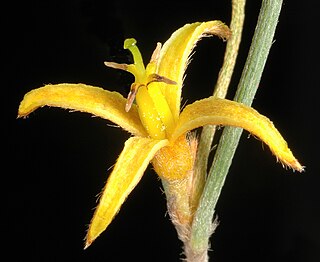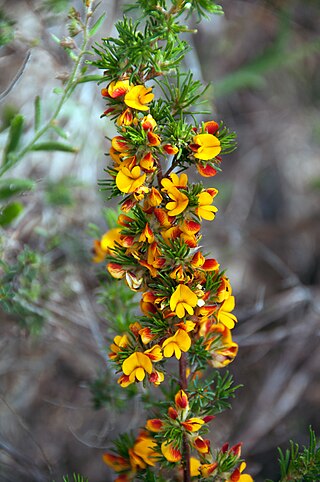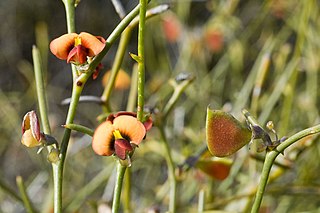Banksia densa is a species of column-like shrub that is endemic to Western Australia. It has deeply serrated to pinnatifid leaves, creamy yellow flowers in heads of up to seventy-five, and hairy follicles.
Banksia tortifolia is a small, spreading, prostrate shrub that is endemic to the southwest of Western Australia. It has short underground stems, pinnatipartite leaves with sharply-pointed, linear lobes on each side, greenish-cream, yellow and pink flowers in heads of about eighty, and glabrous, egg-shaped follicles.

Grevillea acuaria is a species of flowering plant in the family Proteaceae and is endemic to the south-west of Western Australia. It is a rounded, bushy to erect shrub with spreading linear to narrowly elliptic leaves and red flowers arranged in small clusters.

Pultenaea muelleri, commonly known as Mueller's bush-pea, is a species of flowering plant in the family Fabaceae and is endemic to Victoria, Australia. It is a dense shrub with hairy stems, elliptic to narrow egg-shaped leaves with the narrower end towards the base, and yellow and red flowers arranged singly or in pairs on the ends of short side shoots.

Persoonia angustiflora is a species of flowering plant in the family Proteaceae and is endemic to the south-west of Western Australia. It is an erect shrub with hairy branches and leaves, linear, more or less cylindrical leaves and yellow or greenish yellow flowers arranged singly or in groups of up to four.

Isopogon buxifolius is a species of plant in the family Proteaceae and is endemic to the south-west of Western Australia. It is an upright shrub with egg-shaped to elliptic or oblong leaves and clustered spikes of pink flowers.

Isopogon spathulatus is a species of flowering plant in the family Proteaceae and is endemic to south-western Western Australia. It is a shrub with linear to egg-shaped leaves with the narrower end towards the base, and more or less spherical heads of hairy pink flowers.

Grevillea hirtella is a species of flowering plant in the family Proteaceae and is endemic to the west of Western Australia. It is a spreading shrub with crowded linear and divided leaves and clusters of pale pink to deep red flowers.

Petrophile semifurcata is a species of flowering plant in the family Proteaceae and is endemic to an area near the west coast of Western Australia. It is an erect, bushy shrub with sharply-pointed, needle-shaped, sometimes lobed leaves and oval heads of silky-hairy, whitish, lemon-yellow or cream-coloured flowers.

Boronia wilsonii is an erect shrub that is endemic to northern Australia. Its branches, leaves and backs of the flowers are densely covered with woolly hairs. The petals are white to pink or burgundy-coloured.
Dillwynia divaricata is a species of flowering plant in the family Fabaceae and is endemic to the south-west of Western Australia. It is an erect, spindly shrub with cylindrical, grooved leaves and yellow flowers with brownish markings.

Pultenaea acerosa, commonly known as bristly bush-pea, is a species of flowering plant in the family Fabaceae and is endemic to south-eastern continental Australia. It is a rigid, much-branched shrub with glabrous, grooved, needle-shaped leaves and yellow flowers with red veins.
Pultenaea calycina is a species of flowering plant in the family Fabaceae and is endemic to near-coastal areas in the south of Western Australia. It is an erect, spindly shrub with flat or more or less cylindrical, grooved leaves and yellow and orange flowers.

Pultenaea laxiflora, commonly known as loose-flower bush-pea, is a species of flowering plant in the family Fabaceae and is endemic to south-eastern continental Australia. It is a low-lying to prostrate, spreading shrub with linear to narrow egg-shaped leaves with the narrower end towards the base, and yellow and red to brown or purple flowers.
Gompholobium laxum is a species of flowering plant in the family Fabaceae and is endemic to the south-west of Western Australia. It is an erect, open shrub with needle-shaped leaves and uniformly yellow, pea-like flowers.

Gompholobium polymorphum is a species of flowering plant in the family Fabaceae and is endemic to the south-west of Western Australia. It is a bushy, straggling shrub or climber with cylindrical leaves with longitudinal grooves and yellow, red or orange, pea-like flowers with yellow, red or orange marks.
Gompholobium roseum is a species of flowering plant in the family Fabaceae and is endemic to the south-west of Western Australia. It is an erect shrub with pinnate leaves and yellow, pink or green, pea-like flowers with pink or green markings.

Gompholobium shuttleworthii is a species of flowering plant in the pea family Fabaceae and is endemic to the south-west of Western Australia. It is an erect shrub with pinnate leaves with five to nine leaflets, and pink or purple flowers with some darker markings.

Gompholobium villosum is a species of flowering plant in the pea family Fabaceae and is endemic to the south-west of Western Australia. It is a slender, erect shrub with simple, needle-shaped leaves with one or two grooves on the lower surface, and violet, pink or purple flowers.

Daviesia major is a species of flowering plant in the family Fabaceae and is endemic to the south-west of Western Australia. It is an erect, many-stemmed shrub with scattered, erect, sharply-pointed, cylindrical phyllodes and orange and red flowers.













